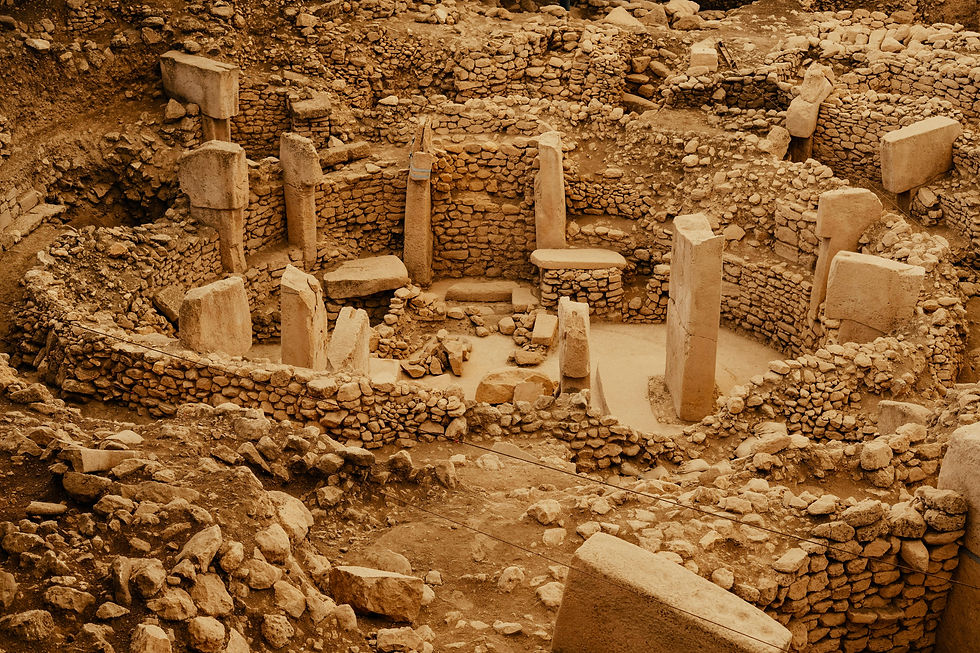
GÖBEKLI & KARAHAN TEPE
(for members only!)
Göbekli Tepe & Karahan Tepe: Before the Pharaohs, Before the Wheel, the Origins of Human Civilisation
Long before the Pharaohs & the Pyramids that rose from the Nile, before the Wheel, before Babylon or Stonehenge or the invention of writing, something astonishing happened in the hills of southeastern Anatolia.
Somewhere between 9500 and 8000 BC—11500 years ago—at the very edge of the last Ice Age, people who had not yet developed metal tools, pottery, or agriculture carved monumental stone pillars and arranged them in circles.
The sites they left behind—most famously Göbekli Tepe, and more recently its sister site Karahan Tepe—are still being uncovered. But they are already rewriting our understanding of early human civilization.
These are not places which can be casually reached on a whim. So if you're looking to visit, you'll almost certainly first land and get set up in Istanbul, before venturing further with a mix of transport.
Until recently, we believed that agriculture came first, then surplus, then religion and cities. Göbekli Tepe turns that idea on its head. Here is evidence that spiritual or ritual life may have preceded settled agriculture—that the urge to gather, create, and commune with something greater than ourselves might have been the spark that built society itself.
You do not need to be an archaeologist to feel the shock of it. Standing before these massive, T-shaped stones—some more than 5 meters tall, etched with leaping lions, foxes, and vultures—you’re confronted not just with their age, but with a silence that stretches across ten millennia.
These sites are one of the most profound clues into the origins of human history that we have.
Here's what we think should form the core of your experience:
Göbekli Tepe: The First Temple?
First noted in an archeological survey from 1963, and first excavated in 1994 by German Archeologist Klaus Schmidt, Göbekli Tepe is now a UNESCO World Heritage Site.
The site lies atop a barren ridge overlooking the Mesopotamian plains. What appears to be a hill is in fact a tell—a man-made mound covering millennia of human activity.
Excavations have revealed multiple circular enclosures, each formed by upright pillars arranged with uncanny precision. The stones are carved with reliefs of animals—snakes, boars, birds—and abstract symbols whose meanings remain elusive.
Until recently no hearths, no homes, or burials (although human bones are not entirely absent from the site) were found, and the general consensus was that this was not a place where people lived, merely where they gathered. Recent excavations have begun to challenge this assumption however, and signs of some domestic structures are beginning to emerge.
Unlike many of Turkey's other essential archeological site visits, Ephesus or Cappadocia, for example, it is still very much early days in terms of our understanding of the Tepe cultures.
You’ll approach on foot, through dry grass and shifting light, and as you step onto the raised walkway above the site, it hits you: this was made by people without cities, yet capable of extraordinary vision and cooperation.
With a guide, the iconography begins to speak, and there is some speculation that these symbols may even prefigure early astronomy, or encode mythic systems we barely recognize.
Karahan Tepe: Deeper, Stranger, Older
Roughly 35 kilometers southeast, only recently opened to the public and still in active excavation, Karahan Tepe is one of at least a dozen other sites identifiably belonging to the Tepe cultures.
If Göbekli Tepe raises questions, Karahan Tepe deepens them.
Here, the stonework appears even more ambitious, with vast subterranean chambers, for example.
And more than that, it is enormously potent in its symbolism: 11 enormous penises rise straight out of the bedrock where they are addressed by a bearded head with a serpent’s body that emerges from the wall, and a central “head cult” chamber is lined with stylized human faces.
The phallic obsession cannot help but remind the archeologically fascinated of the Roman obsession with phalluses as good luck charms and household ornaments, but of course there is no way to understand if or how there is any connection across the vast ocean of time between these two cultures.
There is speculation at present that this site may predate Göbekli Tepe, or at least represent a different facet of the same ritual culture.
Because Karahan Tepe is less developed for tourism, it retains a raw, almost eerie presence.
The sense of standing at the threshold of human religion, identity, and symbolism is more palpable here than almost anywhere on Earth.
If you're interested in a great read, we highly recommend Sean Thomas's Spectator article.
Context, Silence & the Birth of Meaning
These are not easy sites to reach, nor should they be rushed. They deserve interpretation, quiet, and time.
Plan to visit with a knowledgeable guide with archaeological training and local research connections (we’ve got you covered, not to worry!).
The regional museum in Şanlıurfa (Urfa) offers helpful context, displaying original stelae and explaining the broader Neolithic landscape. You’ll want to read widely—on pre-pottery Neolithic cultures, on symbolism and early belief systems—but nothing can replace the experience of being there in person.
Watch the light shift across the stones. Listen to the wind on the ridge.
Think about a world without writing, without kings or armies or wheels, where nonetheless people gathered to carve their fears, hopes, and cosmologies into stone.
And a bunch of giant pensises. Because that was evidently also a good idea.
Skip the Middleman. Meet the Best Guides at Göbekli & Karahan Tepe.
GGG MEMBERS SECTION
Visiting Göbekli Tepe and Karahan Tepe is about stepping into the origins of meaning itself.
GGG members connect with archaeologically trained guides who can contextualize these sites within the wider Neolithic landscape, open doors to restricted dig zones when possible, and translate the symbolism carved into stone.
Our guides help handle the logistics — 4WD transport, museum entry, regional navigation — so you can focus on the experience.